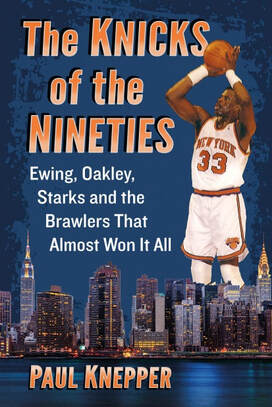
That’s the short history, which gained more weight with the airing of “The Last Dance,” the ESPN miniseries released earlier this year. The perception became even clearer when Charles Smith’s shots were rejected four times by the Bulls in the final seconds of Game 5 in the 1993 Eastern Conference Finals.
Doc Rivers would compare that sequence to “the sudden death of a family member who was perfectly healthy,” Paul Knepper writes in his meticulously researched book, The Knicks of the Nineties: Ewing, Oakley, Starks and the Brawlers That Almost Won It All (McFarland; hardback; $35; 288 pages).
The Knicks certainly came close. They qualified for the playoffs for 14 consecutive seasons from 1987-1998 to 2000-2001. They lost in the finals twice (1994 and 1999) and fell in the conference finals five times.
Knepper, a Jericho, New York, native who now lives in Austin, Texas, rooted for the Knicks as a youth.
“I think about the Knicks more than I should,’’ Knepper told the New York Post. “I’m one of those people who long for those days in the ’90s.”
Knepper, an attorney who graduated from the University of Michigan and earned his juris doctor from the Fordham University School of Law, has a lawyer’s eye for detail. For his first book, he conducted 88 interviews with former players, coaches and executives. The insights of former Knicks and Madison Square Garden president Dave Checketts give Knepper’s work plenty of depth and context.
Knepper’s bibliography includes 31 books, five newspapers, two magazines and websites such as ESPN.com and Basketballreference.com.
Knepper, who began researching Knicks of the Nineties three years ago, peppers his narrative with brief stories about key players — and bit part actors. Coach Pat Riley, for example, was a gym rat and a basketball junkie despite his slicked-back look and expensive Armani suits. “If ‘The Boss’ was ‘Born to Run,’ Riley was born to coach,” Knepper writes. Riley was also a “master motivator,” sometimes turning his back on a player in an elevator or sending messages through the media. Other times, he would challenge players directly.
“Some days you’d think you were coming in for a promotion and you were Joe Pesci. You’d wind up on the floor in your own blood. That’s what working in Madison Square Garden was like. You just never know.” -@MikeWiseguy #theknicksofthenineties pic.twitter.com/mrFK8dYKkD
— Paul Knepper (@paulieknep) November 12, 2020
As for his players, Riley loved John Starks’ competitive spirit, even though “he played at full speed all the time, had questionable shot selection and was reckless with the ball,” Knepper writes.
Charles Oakley was the Knicks’ “thug,” Knepper writes, a 6-foot-9 enforcer who put fear into opposing players. He became a franchise cornerstone, a player beloved by fans because “he collected as many floor burns as baskets.”
After a few misses, the Knicks reached the NBA Finals in 1994, employing a strong defense and a workmanlike ethic. New York took a 3-2 series lead against the Rockets in the Finals and headed to Houston needing just win to earn the NBA title. They lost both games.
Starks, who scored 16 of the Knicks final 22 points in Game 6, went up for a shot from the left corner with New York trailing by two and seconds remaining. Somehow, Hakeem Olajuwon managed to get a finger on the ball, and it fell short of the hoop. Ewing was open but Starks did not pass to him.
Before Game 7, Riley spent the afternoon at his hotel with close friend Dick Butera, Knepper writes. As they waited for an elevator, Riley said to Butera, “Well, buddy, I know three guys that are gonna show up tonight.”
“Who?” Butera asked.
“You, me and John (Starks), Riley said.
Riley stuck with Starks in Game 7 despite poor shooting (2-for-18, and 1-for-10 in the second half). “Feast or Famine shot the Knicks out of the game,” Knepper writes.
Van Gundy, short and underappreciated, seemed to be “a polar opposite” to Riley, but shared his mentor’s fiery competitiveness. He was a tireless worker who was detail-oriented and obsessive about basketball.
The players knew Van Gundy had their backs. A memorable brawl between the Knicks and Heat included Van Gundy, knocked to the floor during the fight, hanging onto Alonzo Mourning’s leg. “It remains the most recognizable image of Van Gundy’s career with the Knicks,” Knepper writes.
Van Gundy also knew how to work the officials. After the Knicks eliminated the Heat in the playoffs to become the second eighth seed to knock off a No. 1 in the postseason, Van Gundy was still arguing with a referee.
“What are you doing?” Checketts asked. “We won.”
“Coaching for the next round,” Van Gundy said.
Knepper also highlights the bizarre and drama that always seemed to swirl around the Knicks. For example, in 1999, Checketts invited Ernie Grunfeld, the team’s general manager who had been with the team’s front office for nearly a decade, to dinner and fired him “over biscotti and fresh fruit.”
Knepper’s narrative about Ewing, who he calls “The Big Fella,” is also interesting. Ewing was one of the most coveted players coming out of college after starring for Georgetown, and he was a force for the team for a decade. All he lacked was a championship ring.
Ewing was “respected, but never loved,” Knepper writes.
Readers are fortunate that Knepper did not write The Knicks of the Nineties in lawyer-speak. His prose is insightful and filled with colorful anecdotes, written mostly with an impartial approach, but also at times exposing his original allegiance. Sometimes Knepper gets too familiar, referring to players by their first names or nicknames, but it is part of the book’s charm.
The Knicks of the 1990s may not have reached the pinnacle of the NBA, but they sure came close. Knepper brings that exciting era of New York basketball back to life.
 RSS Feed
RSS Feed
